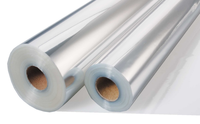








Cellophane is a thin, transparent sheet made of regenerated cellulose. Its low permeability to air, oils, greases, bacteria and water makes it useful for food packaging. Cellophane is in many countries a registered trade mark of Innovia Films Ltd based in Wigton, Cumbria, United Kingdom.
Cellophane film was invented by Jacques E Brandenberger in 1908, a Swiss textile engineer who first thought of the idea for a clear, protective, packaging layer in 1900.
Brandenberger was seated at a restaurant when a customer spilt wine onto the tablecloth. As the waiter replaced the cloth, Brandenberger decided that he should invent a clear flexible film that could be applyed to cloth, making it waterproof.
Jacques E Brandenberger experimented with many different materials, including applying liquid viscose (a cellulose product known as rayon) to cloth, however, the viscose made the cloth too stiff. The experiment failed but Brandenberger noted that the coating peeled off in a transparent film.
Like so many inventions, the original use for Cellophane film was abandoned and new and better uses were found. By 1908, Brandenberger developed the first machine for the manufacture of transparent sheets of regenerated cellulose. By 1912, Brandenberger was making a saleable thin flexible film used in gas masks.
Cellulose film has been manufactured continuously since the mid-1930s and is still used today. As well as packaging a variety of food items, there are also industrial applications, such as a base for such self-adhesive tapes as Sellotape and Scotch Tape, a semi-permeable membrane in a certain type of battery, as dialysis tubing (Visking tubing), and as a release agent in the manufacture of fibreglass and rubber products. In the UK and in many other countries, "cellophane" is a registered trademark and the property of Innovia Films Group, based in Wigton.However, in the US and some other countries "cellophane" has become genericized, and is often used informally to refer to a wide variety of plastic film products, even those not made of cellulose,such as plastic wrap.
Cellophane sales have dwindled since the 1960s, due to alternative packaging options. The polluting effects of carbon disulfide and other by-products of the process used to make viscose may have also contributed to this; however, cellophane itself is 100% biodegradable, and that has increased its popularity as a food wrapping. Cellophane is the most popular material for manufacturing cigar packaging; its permeability to moisture makes cellophane the perfect product for this application as cigars must be allowed to "breathe" while in storage.
When placed between two plane polarizing filters, cellophane produces prismatic colours due to its birefringent nature. Artists have used this effect to create stained glass-like creations that are kinetic and interactive.